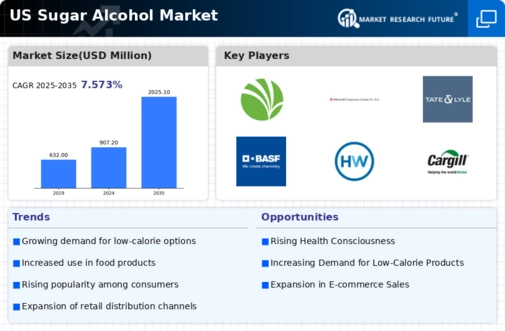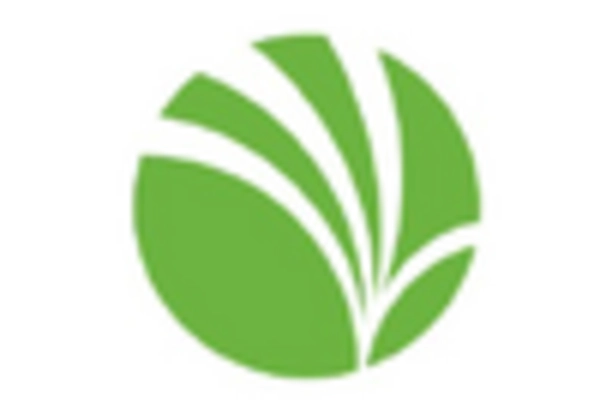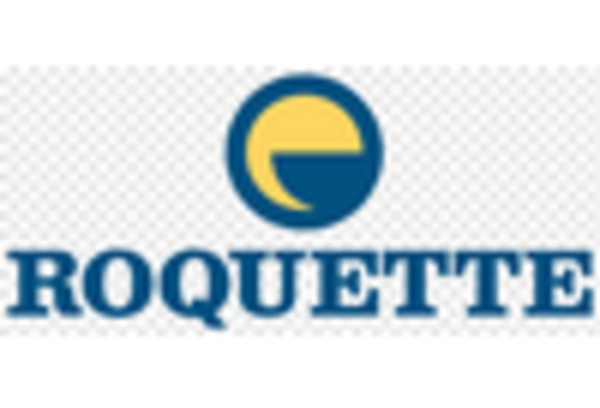Rising Interest in Functional Foods
The sugar alcohol market is experiencing growth due to the rising interest in functional foods, which are designed to provide health benefits beyond basic nutrition. Consumers are increasingly looking for products that support overall wellness, including digestive health and weight management. Sugar alcohols, known for their low-calorie content and potential prebiotic effects, are becoming integral to the formulation of functional foods. Market data suggests that the functional food market is projected to reach $275 billion by 2025, indicating a robust opportunity for sugar alcohols to be incorporated into a variety of health-focused products. As the demand for functional foods continues to rise, the sugar alcohol market is likely to expand, with manufacturers innovating to create products that cater to health-conscious consumers seeking added benefits.
Increased Focus on Clean Label Products
The sugar alcohol market is benefiting from the rising consumer demand for clean label products, which emphasize transparency and natural ingredients. As consumers become more discerning about food labels, they are increasingly seeking products that contain recognizable and minimally processed ingredients. Sugar alcohols, often derived from natural sources, align well with this trend, making them an appealing choice for manufacturers aiming to meet consumer expectations. Market data indicates that the clean label market is expected to grow at a CAGR of 7% through 2026, further highlighting the potential for sugar alcohols to gain traction. This focus on clean labels is likely to drive innovation within the sugar alcohol market, as companies explore new formulations and marketing strategies that emphasize the natural origins and health benefits of their products.
Expansion of the Food and Beverage Industry
The sugar alcohol market is significantly influenced by the expansion of the food and beverage industry in the US. As the industry continues to grow, there is an increasing incorporation of sugar alcohols in various products, including snacks, beverages, and baked goods. This trend is supported by market data showing that the food and beverage sector is expected to reach a valuation of over $1 trillion by 2026. The versatility of sugar alcohols, which can enhance flavor while providing lower calorie content, makes them an attractive ingredient for manufacturers. Additionally, the rise of functional foods and beverages, which often utilize sugar alcohols for their health benefits, further propels market growth. As consumer preferences shift towards healthier options, the sugar alcohol market is likely to benefit from the ongoing expansion and innovation within the food and beverage industry.
Increasing Demand for Low-Calorie Sweeteners
The sugar alcohol market is experiencing a notable increase in demand for low-calorie sweeteners, driven by a growing consumer preference for healthier food options. As individuals become more health-conscious, they are actively seeking alternatives to traditional sugars that offer fewer calories and lower glycemic indices. This shift is reflected in market data, indicating that the sugar alcohol market is projected to grow at a CAGR of approximately 5.5% from 2025 to 2030. The rising prevalence of obesity and diabetes in the US further fuels this trend, as consumers look for ways to reduce sugar intake without sacrificing taste. Consequently, manufacturers are expanding their product lines to include sugar alcohols, catering to the evolving preferences of health-oriented consumers. This increasing demand is likely to drive innovation and competition within the sugar alcohol market, as companies strive to meet the needs of a more health-conscious population.
Growing Popularity of Keto and Low-Carb Diets
The sugar alcohol market is witnessing a surge in popularity due to the increasing adoption of keto and low-carb diets among consumers. These dietary trends emphasize the reduction of carbohydrate intake, leading individuals to seek sugar alternatives that align with their nutritional goals. Sugar alcohols, known for their low glycemic impact, are becoming a preferred choice for those following such diets. Market data suggests that the keto diet market alone is projected to reach $15 billion by 2027, indicating a substantial opportunity for sugar alcohols to penetrate this segment. As more consumers embrace these dietary lifestyles, the sugar alcohol market is likely to see a corresponding rise in demand, prompting manufacturers to develop products that cater specifically to this audience. This trend not only supports the growth of the sugar alcohol market but also encourages innovation in product formulations.

















Leave a Comment